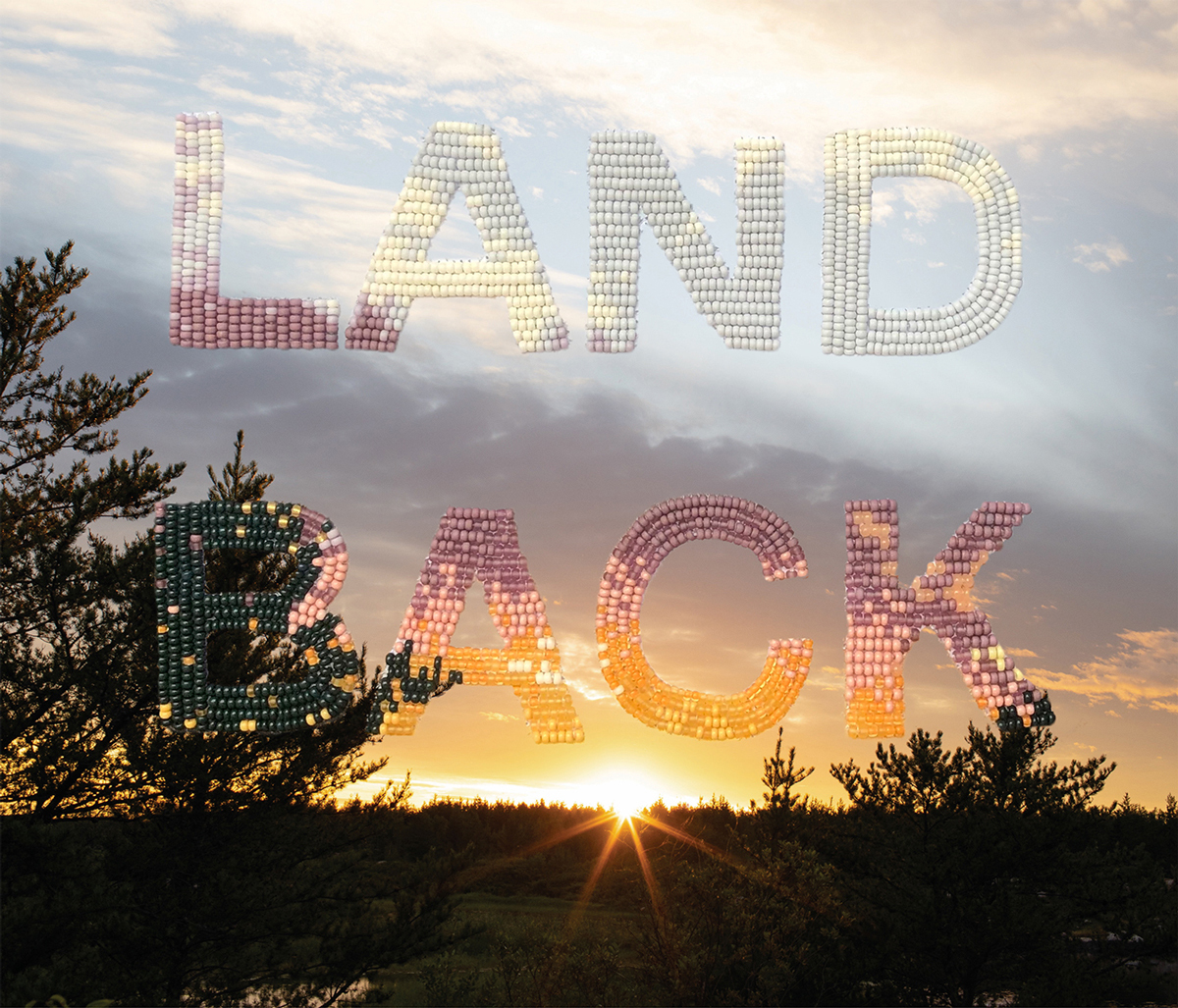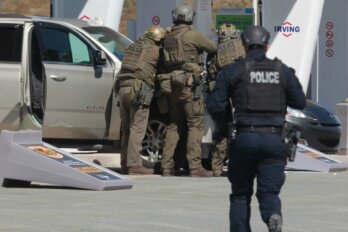In an empty loft off Highway 6, along a stretch of country road that connects Six Nations of the Grand River with the nearby town of Caledonia, eight people banter around a midafternoon fire. This grassy field in southern Ontario, dotted with a few tents and temporary structures, is called Kanonhstaton. Back in 2006, it was the future site of a 600-home subdivision. Members of Six Nations, which claims ownership of the land, moved in and halted construction, leading to a months-long standoff that began to de-escalate only when the province bought out the land from the developer and abandoned the project. Today, Kanonhstaton serves as the headquarters for a new land fight, this one just across the road. There, Foxgate Developments is planning to turn twenty-five acres of farmland into McKenzie Meadows, a suburb of 218 homes. Haudenosaunee from Six Nations arrived once again in July, stopping construction, occupying the lots, and renaming the barren field 1492 Land Back Lane. It’s now a new front in the centuries-long struggle between Canada and Indigenous nations over where one another’s sovereignty begins and ends—one that sees the Haudenosaunee at odds with the government, the courts, and many of their neighbours.
Listen to an audio version of this story
For more audio from The Walrus, subscribe to AMI-audio podcasts on iTunes.
Skyler Williams, a thirty-eight-year-old ironworker and spokesperson for the activists, pulls up in a mud-spattered Jeep. He grins and lights a cigarette, and we walk a few hundred metres down the road toward the main blockade, up since October. There, a battered, spray-painted school bus sits atop a ridge of torn-up asphalt, barring one of the main roads into Caledonia. Four Ontario Provincial Police OPP officers, standing outside their vehicles, keep watch from afar. There are arrest warrants out for several of the camp’s members, Williams included, on account of an injunction ordering them to allow construction to resume. The protesters have been disparaged by politicians and police as criminals and outlaws, but among their supporters, they have another name: land defenders. They haven’t left, and the situation has now settled into a tense stalemate.
Williams tells me that, though he’s the group’s spokesperson, he isn’t its leader. That responsibility lies with a collective of unnamed women, in keeping with the Haudenosaunee’s matriarchal society—the anonymity, he explains, is necessary to shield them from harassment and legal ramifications. However, Williams’s public-facing role may have put him on the hook for nearly $20 million in legal fees, per an order from an Ontario Superior Court judge. Still, he’s undeterred. “Indigenous people are continuing to be forced to make a stand for the health, the safety, the futures of our people,” he says.
The conflict playing out at Land Back Lane has roots dating back 250 years. The proposed site of McKenzie Meadows falls on the Haldimand Tract, a parcel of roughly 950,000 acres granted by the Crown to its Haudenosaunee allies in 1784, after many were displaced from their New York territories following the American Revolutionary War. The deal gave the Haudenosaunee ten kilometres on both sides of the Grand River, a ribbon of land that unspools over some 200 kilometres, from the river’s headwaters, near Orangeville, in the north, to Lake Erie, in the south. Today, the Haudenosaunee at Six Nations—the most populous reserve in Canada, with more than 27,000 members—control just 5 percent of their original land. The government says that the Haudenosaunee Confederacy sold most of it back in the 1800s; many Haudenosaunee say that much of the land was illegitimately taken.
Since 1980, the Six Nations council has submitted twenty-nine separate land claims through the courts to try to remedy the situation. Only one—the original 1980 filing—has been resolved to date. And, as the cases languish in the legal system, the Haudenosaunee have watched their lands shrink, piece by piece turned over to encroaching construction. Once houses arrive, the best Six Nations can hope for is monetary compensation—the territory itself is lost. The movement at Land Back Lane, then, is a last-ditch attempt to prevent their homelands from shrinking any further.
The unrest in Caledonia is just one of many high-profile land disputes that have unfolded over the past year. From Mi’kma’ki on the Atlantic coast, where lobster fishers are defending their treaty right to the ocean harvest, to British Columbia, where the Secwépemc and Wet’suwet’en are blocking construction projects on contested territories, land defenders say they are merely enforcing the rights they were promised and calling in debts that are owed.
In previous decades, these conflicts often played out in isolation, but today, there’s a growing and concerted effort from nations across North America to support one another in their struggles, with thousands rallying in person and online under the banner of the #LandBack movement. At Land Back Lane, this has taken the form of Indigenous folks showing up from across the country to stand guard with the defenders, bring supplies, orchestrate solidarity rallies, and donate to a legal-defence fund. The occupation, now stretching into the winter, has no end in sight. As Williams says, “People across all of Turtle Island right now have been oppressed to such a degree that there isn’t much choice in the matter for us. We’re going to have nothing left for our grandchildren.”
The legal defence of land reclamation hinges on the question of authority. Many First Nations, Métis, and Inuit see their territories as independent states with their own laws. Meanwhile, the Constitution Act is vague in defining what level of authority it sees these nations possessing, and, as a result, disputes have continuously cropped up over where Indigenous nations’ powers end and Canada’s begin. “Most Canadians believe that [Canada] encapsulates the entire land mass that we see on a map,” says Matthew Green, MP for Hamilton Centre and one of the few local representatives who support Land Back Lane. “This is a legal fiction of Canada, and we have to come to grips with that.”
The animosity that these disputes raise, Green says, is easy to understand: as a city councillor, he often saw neighbours in his ward “go to war like they were Hatfield and McCoy over under a foot of a fence variance for a property line.” For many First Nations, the land in question is exponentially larger—and essential to their futures. As recent history has shown, taking direct action is often the only way Indigenous communities can get the government to act.
In 1990, Mohawks at Kanehsatà:ke set up a camp on their traditional territory, which borders the nearby Quebec town of Oka. The municipality was planning to build a golf course on the land, which contains Mohawk burial grounds. The standoff saw armed land defenders staring down the army and police, lasting more than two months and leading to widespread media coverage. The government eventually agreed to purchase the land and leave it undeveloped, though tension over ownership remains. Five years later, it was the Chippewas of the Kettle and Stony Point First Nation, in Ontario, who fought to regain hundreds of acres that the country had commandeered. Some of it had been sold under government pressure in the 1920s and turned into Ipperwash Provincial Park; during the Second World War, more land was appropriated and turned into military training grounds. When members of Stony Point First Nation set up their camp in 1995, the OPP was deployed and a brief siege ensued. The authorities eventually killed Dudley George, who was unarmed, leading to a three-year-long inquiry. Last September, some of the land at Ipperwash was finally returned to the Chippewas of the Kettle and Stony Point.
Beverly Jacobs, associate dean of the University of Windsor faculty of law and faculty adviser to the 1492 Windsor Law Coalition, which works in support of Land Back Lane, says that the Canadian legal system often takes decades or longer to resolve land disputes—the claim at Kanehsatà:ke, for example, was first raised in 1761 and remains contested to this day. When faced with imminent development that would make future ownership impossible, direct action can be the only option left. “If there was another way, it would be done,” Jacobs says. “Our young people, they want something done now because my generation, my parents, my grandparents, have been through the same struggle, and they’re just tired of it.”
It’s a sentiment echoed by Courtney Skye, a Mohawk research fellow and policy analyst who has been a regular presence at Land Back Lane. She says that, in spite of the many legal wins Indigenous people have achieved in recent decades—via the Charter of Rights and Freedoms, amendments to the Indian Act, and the creation of the Truth and Reconciliation Commission of Canada—when it comes to true self-determination, little has actually changed. “[The previous generation] gained all these tools and all these avenues in a policy and technical sphere, and the next generation has just witnessed how none of those strategies worked,” she says. “For a lot of people, they’ve come to the conclusion that the only thing that actually makes a difference is direct action and radical land reclamation.”
But, more often than not, protests prompt force rather than diplomacy. The OPP is a constant presence at Land Back Lane—last October, officers moved in and fired rubber bullets and tasers at those assembled. The previous month, Skye was pulled out of a friend’s SUV and arrested—according to those at Land Back Lane, she’s one of thirty-six charged to date. Ken Hewitt, mayor of local Haldimand County, has a down payment on a home in McKenzie Meadows. He’s publicly applauded the arrest of Skyler Williams’s wife, Kahsenniyo, and wrote that he would “look forward to hearing of [Skyler’s] arrest shortly.” Last September, the Haldimand County Police Services Board called the land defenders “terrorists” in a meeting document and encouraged the OPP to crack down harder on them.
Heavy-handed responses have come to be expected by Indigenous activists. “When people take things into their own hands, then the whole weight of the system comes crushing down on Indigenous people,” says Karl Dockstader, an Oneida journalist and host of the radio program One Dish, One Mic. Dockstader is one of many reporters who have travelled to Land Back Lane to document the protest, but unlike most others, he has been targeted for doing so. Last September, he was arrested and charged with mischief and failure to comply with an injunction. It was three months before the charges were dropped.
Political organizing between Indigenous nations has always been present, from the Nisga’a’s Land Claims Agreement Coalition, in British Columbia, to the allied Coast Salish nations that banded together in the 1800s to protect themselves against nearby powers. During the Mohawk defences in Kanehsatà:ke, solidarity protests, leafleting, and blockades occurred from Toronto to Vancouver. But, with the new #LandBack movement, people say that alliances have been accelerating. Photos of RCMP officers breaching the barricades at Wet’suwet’en, or of settler fishers attacking Mi’kmaw workers, are instantly circulated across nations via social media, leading to rail blockades, solidarity marches, and grassroots fundraising.
Raven-Chanelle Augustine, from Elsipogtog First Nation, an hour north of Moncton, has been on the front lines of the fisheries dispute in Mi’kma’ki. It’s a movement, she says, that has united Mi’kmaw nations despite their long-standing differences. “When things go down, when the commercial fishermen are out here setting things on fire, our people really know how to show up for each other,” she says.
Shady Hafez, an Anishinaabe community member from Kitigan Zibi, was involved in the Algonquins of Barriere Lake’s blockade against Quebec hunters last fall, an action to address declines in local moose populations. “I had to tell people so many times, ‘This is not your playground—this is not yours,’” he says. “We have no problem sharing, but if we’re saying you need to take a break, then you need to take a break. Our jurisdiction needs to be acknowledged.” Hafez says his community faced retaliation for its actions—people shot up signs and barricades and spread butchered moose parts around the blockades—but the blockade was nonetheless a success. “Organizers both young and old in our community are prepared now,” he says, “and are organized in a way that we weren’t before.”
When the RCMP invaded Wet’suwet’en territory in January 2020, the Mohawk of Tyendinaga blocked rail lines in Ontario—one small part of the nationwide #ShutDownCanada movement, which eventually forced a sit-down with the federal minister of Indigenous services, Marc Miller. Last October, people at Land Back Lane orchestrated a rolling car blockade to show support for Mi’kmaw fishers. This kind of inter-nation support from east to west may be the biggest threat to the government’s slow-moving response to Indigenous sovereignty.
The original treaties between settlers and Indigenous nations were drawn up not out of benevolence, Skye says, but because of a “cost-benefit analysis.” Back then, the government concluded that continued skirmishes were too expensive. It was forced to come to the table and make deals. With the #LandBack movement growing, it may come to the same realization. As Skye explains, “It is always because of Indigenous resistance and Indigenous organizing that Indigenous people still exist.”





